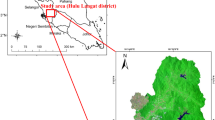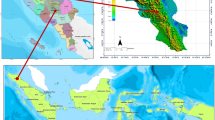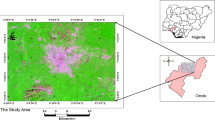Abstract
Urban heat island (UHI) is a phenomenon which may have adverse effects on our environment and is stimulated as a result of urbanization or land cover changes. Thermal remote sensing has been found beneficial to study the effect of urbanization on UHI intensity. This paper analyses the variation in land surface temperature (LST) with land cover changes in Varanasi city of India from 1989 to 2018 using Landsat satellite images. A new index named Urban Heat Intensity Ratio Index (UHIRI) was proposed to quantify the urban heat intensity from 1989 to 2018 which was found to increase from 0.36 in year 1989 to 0.87 in year 2018. Further, contribution of each land cover towards UHI was determined using land cover contribution index (LCCI). The negative value of LCCI for water and vegetation indicates its negative contribution towards UHI, whereas positive value of LCCI for bare soil and built-ups depicted its positive contribution towards UHI. The LCCI value for urban land cover shows significant increase in 29 years, i.e. 0.49, 1.43, 3.40 and 4.37 for years 1989, 1997, 2008 and 2018, respectively. The changes in normalized LST from years 1989 to 2018 for the conversion of bare land to built-ups and vegetation to built-ups were found to be as −0.11 and 0.42, respectively. This led to conclusion that the replacement of vegetation with urban land cover has severe impact on increasing UHI intensity.










Similar content being viewed by others
Availability of data and material
The Landsat satellite data was used for the study and downloaded from the website of Earth Explorer that was freely available for users.
Code availability
Software: Envi 5.1, Matlab, QGIS.
References
Alberts JH (1998). Public tubewell irrigation in Uttar Pradesh, India: a case study of the indo-Dutch tubewell project. International Institute for Land Reclamation and Improvement
Amiri R, Weng Q, Alimohammadi A, Alavipanah SK (2009) Spatial–temporal dynamics of land surface temperature in relation to fractional vegetation cover and land use/cover in the Tabriz urban area, Iran. Remote Sens Environ 113(12):2606–2617
Aniello C, Morgan K, Busbey A, Newland L (1995) Mapping micro-urban heat islands using Landsat TM and a GIS. Comput Geosci 21(8):965–969
Barsi JA, Schott JR, Palluconi FD, Hook SJ (2005) Validation of a web-based atmospheric correction tool for single thermal band instruments. In: Earth observing systems X (Vol. 5882, p. 58820E). International Society for Optics and Photonics, Bellingham, Washington
Chen X-L, Zhao H-M, Li P-X, Yin Z-Y (2006) Remote sensing image-based analysis of the relationship between urban heat island and land use/cover changes. Remote Sens Environ 104(2):133–146
Grigoraș G, Urițescu B (2019) Land use/land cover changes dynamics and their effects on surface urban Heat Island in Bucharest, Romania. Int J Appl Earth Obs Geoinf 80:115–126
Huang C, Thomas N, Goward SN, Masek JG, Zhu Z, Townshend JR, Vogelmann JE (2010) Automated masking of cloud and cloud shadow for forest change analysis using Landsat images. Int J Remote Sens 31(20):5449–5464
Huang Q, Huang J, Yang X, Fang C, Liang Y (2019) Quantifying the seasonal contribution of coupling urban land use types on urban Heat Island using land contribution index: a case study in Wuhan, China. Sustain Cities Soc 44:666–675
Jha DK, Harshwardhan R, Tripathi VK (2019) Geographical zones of Varanasi City: past to present. National Geographical Journal of India 65(1):46–55
Kato S, Yamaguchi Y (2005) Analysis of urban heat-island effect using ASTER and ETM+ data: separation of anthropogenic heat discharge and natural heat radiation from sensible heat flux. Remote Sens Environ 99(1–2):44–54
Keeratikasikorn C, Bonafoni S (2018) Urban heat island analysis over the land use zoning plan of Bangkok by means of Landsat 8 imagery. Remote Sens 10(3):440
Lata S (2019) Irrigation water management for agricultural development in Uttar Pradesh. Springer International Publishing, India
Li H, Zhou Y, Li X, Meng L, Wang X, Wu S, Sodoudi S (2018) A new method to quantify surface urban heat island intensity. Sci Total Environ 624:262–272
Mathew A, Khandelwal S, Kaul N (2016) Spatial and temporal variations of urban heat island effect and the effect of percentage impervious surface area and elevation on land surface temperature: study of Chandigarh city, India. Sustain Cities Soc 26:264–277
Mathew A, Khandelwal S, Kaul N (2018) Investigating spatio-temporal surface urban heat island growth over Jaipur city using geospatial techniques. Sustain Cities Soc 40:484–500
Meng Q, Zhang L, Sun Z, Meng F, Wang L, Sun Y (2018) Characterizing spatial and temporal trends of surface urban heat island effect in an urban main built-up area: a 12-year case study in Beijing, China. Remote Sens Environ 204:826–837
Qiu S, Zhu Z, Woodcock CE (2020) Cirrus clouds that adversely affect Landsat 8 images: what are they and how to detect them? Remote Sens Environ 246:111884
Rao PK (1972) Remote sensing of urban heat islands from an environmental satellite. Bull Am Meteorol Soc 53:647–648
Sarrat C, Lemonsu A, Masson V, Guedalia D (2006) Impact of urban heat island on regional atmospheric pollution. Atmos Environ 40:1743–1758
Shafizadeh-Moghadam H, Weng Q, Liu H, Valavi R (2020) Modeling the spatial variation of urban land surface temperature in relation to environmental and anthropogenic factors: a case study of Tehran, Iran. GIScience & Remote Sensing 57(4):483–496
Shastri H, Barik B, Ghosh S, Venkataraman C, Sadavarte P (2017) Flip flop of day-night and summer-winter surface urban heat island intensity in India. Sci Rep 7:40178
Shirani-Bidabadi N, Nasrabadi T, Faryadi S, Larijani A, Roodposhti MS (2019) Evaluating the spatial distribution and the intensity of urban heat island using remote sensing, case study of Isfahan city in Iran. Sustain Cities Soc 45:686–692
Singh A (1989) Review article digital change detection techniques using remotely-sensed data. Int J Remote Sens 10(6):989–1003
Streutker DR (2003) Satellite-measured growth of the urban heat island of Houston, Texas. Remote Sens Environ 85:282–289
Sultana S, Satyanarayana ANV (2018) Urban heat island intensity during winter over metropolitan cities of India using remote-sensing techniques: impact of urbanization. Int J Remote Sens 39(20):6692–6730
Taha H (1997) Urban climates and heat islands: albedo: evapotranspiration and anthropogenic heat. Energy and Buildings 25:99–103
Tiangco M, Lagmay AMF, Argete J (2008) ASTER-based study of the night-time urban heat island effect in metro Manila. Int J Remote Sens 29(10):2799–2818
Tran H, Uchihama D, Ochi S, Yasuoka Y (2006) Assessment with satellite data of the urban heat island effects in Asian mega cities. Int J Appl Earth Obs Geoinf 8:34–48
United Nation (2015) World urbanization prospects: the 2014 revision, New York
Van de Griend AA, Owe M (1993) On the relationship between thermal emissivity and the normalized difference vegetation index for natural surfaces. Int J Remote Sens 14:1119–1131
Voogt JA, Oke TR (2003) Thermal remote sensing of urban area. Remote Sens Environ 86:370–384
Yuan F, Bauer ME (2007) Comparison of impervious surface area and normalized difference vegetation index as indicators of surface urban heat island effects in Landsat imagery. Remote Sens Environ 106(3):375–386
Zhang J, Wang Y (2008) Study of the relationships between the spatial extent of surface urban heat islands and urban characteristic factors based on Landsat ETM+ data. Sensors 8(11):7453–7468
Zhang K, Wang R, Shen C, Da L (2010) Temporal and spatial characteristics of the urban heat island during rapid urbanization in Shanghai, China. Environ Monit Assess 169:101–112
Acknowledgements
The authors would like to acknowledge the Department of Physics, Indian Institute of Technology (BHU), Varanasi, India, for providing a research platform and the Council of Scientific and Industrial Research (CSIR), New Delhi, India, for providing the financial support. The authors also wish to thank the U.S. Geological Survey (USGS) for making the satellite data available for study.
Author information
Authors and Affiliations
Contributions
Ruchi Bala: conceptualization, data curation, formal analysis, investigation, methodology, software handling, validation, writing of original draft, writing of review and editing. Rajendra Prasad: resources, supervision, writing of review and editing. Vijay Pratap Yadav: data curation, investigation, software handling, writing of review and editing.
Corresponding author
Ethics declarations
Ethics approval
Not applicable.
Consent to participate
Not applicable.
Consent to publication
Not applicable.
Conflict of interest
The authors declare no competing interests.
Additional information
Publisher’s note
Springer Nature remains neutral with regard to jurisdictional claims in published maps and institutional affiliations.
Rights and permissions
About this article
Cite this article
Bala, R., Prasad, R. & Yadav, V.P. Quantification of urban heat intensity with land use/land cover changes using Landsat satellite data over urban landscapes. Theor Appl Climatol 145, 1–12 (2021). https://doi.org/10.1007/s00704-021-03610-3
Received:
Accepted:
Published:
Issue Date:
DOI: https://doi.org/10.1007/s00704-021-03610-3




